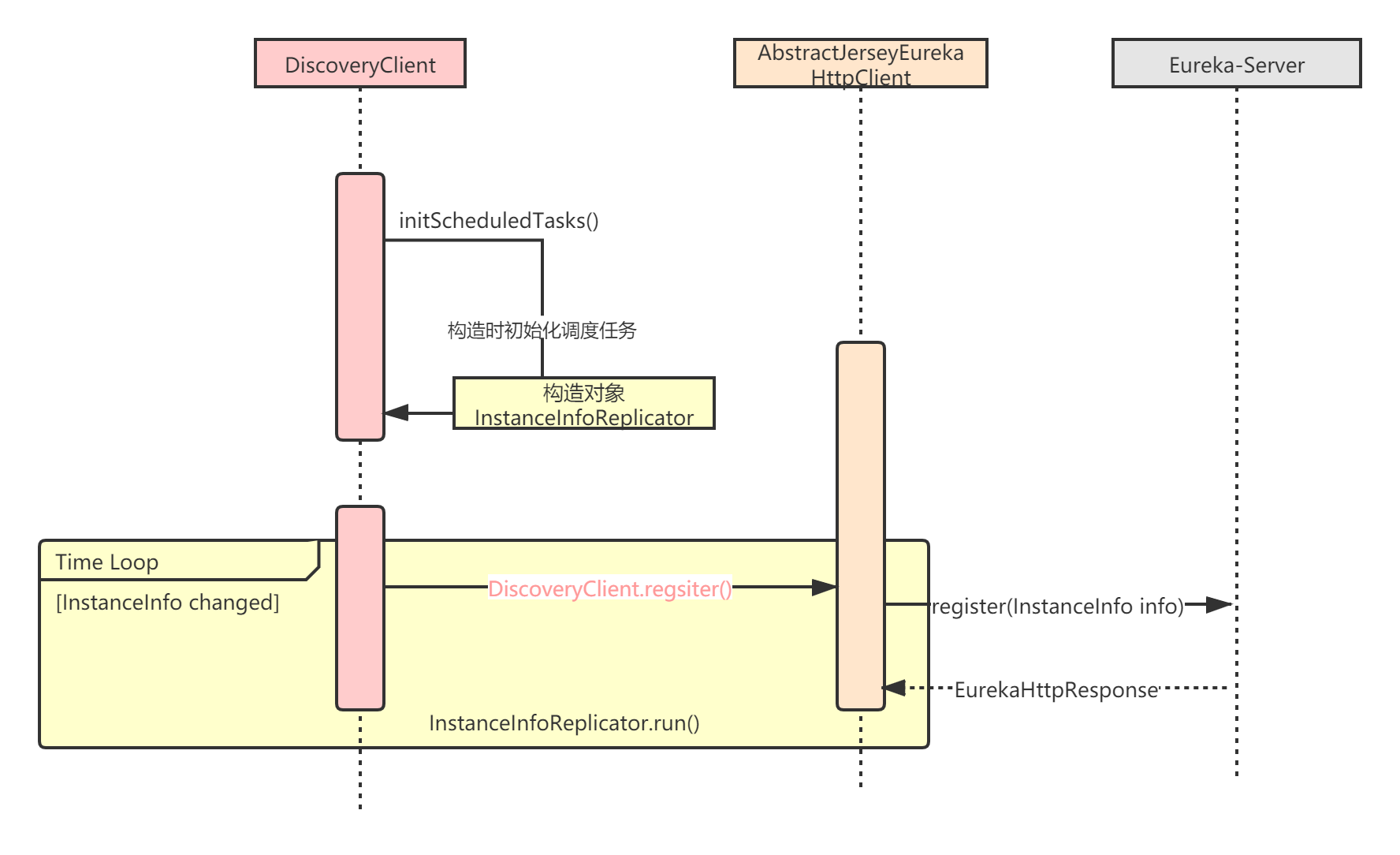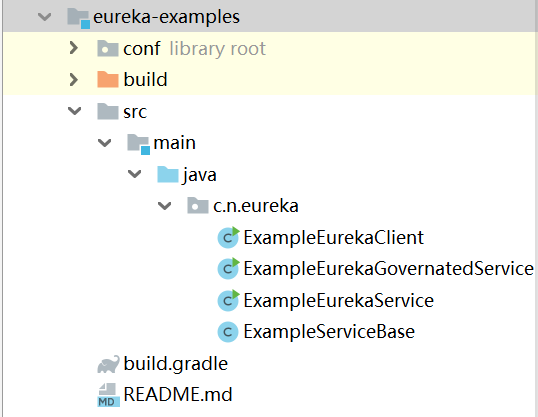从本章开始,我们正式进入Eureka的服务注册流程的学习。Eureka服务注册,我将分两部分来讲解: 客户端(Eureka-Client)发起注册 流程和 服务端(Eureka-Server)接受注册 流程。
Eureka-Client发起注册的核心过程,我用下面这张时序图表示:

注意:在Eureka源码工程目录下,有一个eureka-examples模块,里面包含了很多使用示例,读者可以先去阅读下ExampleEurekaClient和ExampleEurekaService这两个示例:

示例比较简单,我这里就不赘述了,本章主要讲解Eureka-Client发起注册的流程。
一、发起注册流程
1.1 注册条件
Eureka-Client发起注册需要满足以下条件:
- 配置
eureka.registration.enabled = true,这是Eureka-Client 向 Eureka-Server 发起注册应用实例的开关; - Eureka-Client的 InstanceInfo 与 Eureka-Server 侧的数据不一致。
符合条件后,InstanceInfo 不会立即向发起 Eureka-Server 注册,而是通过一个后台线程 定时 注册。每次 InstanceInfo 的 属性变化 时,Eureka-Client会标记 isInstanceInfoDirty 属性为 true,后台线程会定时检测,并发起注册。
注意:如果设置了参数
eureka.shouldOnDemandUpdateStatusChange = true,那么一旦 InstanceInfo 的状态(status) 属性发生变化,就会被监听器监听到,并立即向 Eureka-Server 进行一次注册,不会等待线程池调度。 这个参数默认情况是开启的 。
1.2 initScheduledTasks
Eureka-Client的发起注册入口在一个名为initScheduledTasks的方法中,会在DiscoveryClient对象构造时调用:
/**
* DiscoveryClient.java
*/
// 应用实例状态变更监听器
private ApplicationInfoManager.StatusChangeListener statusChangeListener;
// 应用实例信息复制器
private InstanceInfoReplicator instanceInfoReplicator;
DiscoveryClient(ApplicationInfoManager applicationInfoManager, EurekaClientConfig config, AbstractDiscoveryClientOptionalArgs args, Provider<BackupRegistry> backupRegistryProvider) {
//...
initScheduledTasks();
//...
}
// DiscoveryClient#initScheduledTasks
private void initScheduledTasks() {
//...
if (clientConfig.shouldRegisterWithEureka()) {
//...
// 创建【应用实例复制器】
instanceInfoReplicator = new InstanceInfoReplicator(
this,
instanceInfo,
clientConfig.getInstanceInfoReplicationIntervalSeconds(),
2); // burstSize
// 创建【应用实例状态监听器】
statusChangeListener = new ApplicationInfoManager.StatusChangeListener() {
@Override
public String getId() {
return "statusChangeListener";
}
@Override
public void notify(StatusChangeEvent statusChangeEvent) {
if (InstanceStatus.DOWN == statusChangeEvent.getStatus() ||
InstanceStatus.DOWN == statusChangeEvent.getPreviousStatus()) {
// log at warn level if DOWN was involved
logger.warn("Saw local status change event {}", statusChangeEvent);
} else {
logger.info("Saw local status change event {}", statusChangeEvent);
}
instanceInfoReplicator.onDemandUpdate();
}
};
// 注册【应用实例状态监听器】,用于状态变更时立即发起注册
if (clientConfig.shouldOnDemandUpdateStatusChange()) {
applicationInfoManager.registerStatusChangeListener(statusChangeListener);
}
// 启动【应用实例复制器】,内部会发起服务注册
instanceInfoReplicator.start(clientConfig.getInitialInstanceInfoReplicationIntervalSeconds());
} else {
logger.info("Not registering with Eureka server per configuration");
}
}
可以看到,DiscoveryClient在内部创建了一个应用实例复制器InstanceInfoReplicator。InstanceInfoReplicator是一个Runnable任务,需要被线程池调度执行,实际发起注册的逻辑就在里面。
Eureka服务注册的设计其实不太好,注册和复制完全是两个不同的概念,这个搞了一个InstanceInfoReplicator,把服务注册和实例复制的逻辑混在了一起,不符合“单一职责”原则。而且“注册”这么重要的核心功能还隐藏得这么深,读者后面会看到,整个“注册”的类体系设计非常复杂,个人感觉完全没必要这样设计。
1.3 InstanceInfoReplicator
我们来看下应用实例复制器,这里的关键有两点:
- 将应用实例InstanceInfo置为dirty,这样可以强制发起一次注册;
- 利用InstanceInfoReplicator内部的定时调度线程池,定时调度自己,以进行注册。
/**
* InstanceInfoReplicator.java
*/
class InstanceInfoReplicator implements Runnable {
private static final Logger logger = LoggerFactory.getLogger(InstanceInfoReplicator.class);
private final DiscoveryClient discoveryClient;
// 应用实例信息
private final InstanceInfo instanceInfo;
// 定时执行频率,单位:秒
private final int replicationIntervalSeconds;
// 定时调度线程池
private final ScheduledExecutorService scheduler;
// 定时执行任务的 Future
private final AtomicReference<Future> scheduledPeriodicRef;
// 是否开启调度
private final AtomicBoolean started;
// 限流相关,后续章节讲解
private final RateLimiter rateLimiter;
private final int burstSize;
private final int allowedRatePerMinute;
InstanceInfoReplicator(DiscoveryClient discoveryClient, InstanceInfo instanceInfo, int replicationIntervalSeconds, int burstSize) {
this.discoveryClient = discoveryClient;
this.instanceInfo = instanceInfo;
this.scheduler = Executors.newScheduledThreadPool(1,
new ThreadFactoryBuilder()
.setNameFormat("DiscoveryClient-InstanceInfoReplicator-%d")
.setDaemon(true)
.build());
this.scheduledPeriodicRef = new AtomicReference<Future>();
this.started = new AtomicBoolean(false);
this.rateLimiter = new RateLimiter(TimeUnit.MINUTES);
this.replicationIntervalSeconds = replicationIntervalSeconds;
this.burstSize = burstSize;
this.allowedRatePerMinute = 60 * this.burstSize / this.replicationIntervalSeconds;
logger.info("InstanceInfoReplicator onDemand update allowed rate per min is {}", allowedRatePerMinute);
}
public void start(int initialDelayMs) {
if (started.compareAndSet(false, true)) {
// 设置应用实例Dirty,因为此时服务端没有实例,所以强制发起一次注册
instanceInfo.setIsDirty();
// 延时initialDelayMs时间后,开始调度
Future next = scheduler.schedule(this, initialDelayMs, TimeUnit.SECONDS);
scheduledPeriodicRef.set(next);
}
}
//...
}
InstanceInfoReplicator的start方法会将Runnable任务(也就是它自己)扔给线程池进行调度,所以我们继续看InstanceInfoReplicator.run():
/**
* InstanceInfoReplicator.java
*/
public void run() {
try {
// 1.刷新应用实例信息
// 这里就是看看配置有没有改变;然后用健康检查器,检查下实例状态,更新状态并设置到ApplicationInfoManager中
discoveryClient.refreshInstanceInfo();
// 2.判断应用实例信息是否改变过,首次注册时因为强制设置dirty,所以肯定不为null
Long dirtyTimestamp = instanceInfo.isDirtyWithTime();
if (dirtyTimestamp != null) {
// 3.发起注册
discoveryClient.register();
// 重置实例ditry状态
instanceInfo.unsetIsDirty(dirtyTimestamp);
}
} catch (Throwable t) {
logger.warn("There was a problem with the instance info replicator", t);
} finally {
// 4.再次提交任务
Future next = scheduler.schedule(this, replicationIntervalSeconds, TimeUnit.SECONDS);
scheduledPeriodicRef.set(next);
}
}
注意,上述流程中,发起注册完成后,在finally里又调用 ScheduledExecutorService#schedule(...) 方法,再次延迟执行任务。Eureka-Client就是通过这样的方式,不断 循环 定时执行服务注册任务的。
说实话,这种定时调度的方式真的有点奇葩。
Java 面试宝典是大明哥全力打造的 Java 精品面试题,它是一份靠谱、强大、详细、经典的 Java 后端面试宝典。它不仅仅只是一道道面试题,而是一套完整的 Java 知识体系,一套你 Java 知识点的扫盲贴。
它的内容包括:
- 大厂真题:Java 面试宝典里面的题目都是最近几年的高频的大厂面试真题。
- 原创内容:Java 面试宝典内容全部都是大明哥原创,内容全面且通俗易懂,回答部分可以直接作为面试回答内容。
- 持续更新:一次购买,永久有效。大明哥会持续更新 3+ 年,累计更新 1000+,宝典会不断迭代更新,保证最新、最全面。
- 覆盖全面:本宝典累计更新 1000+,从 Java 入门到 Java 架构的高频面试题,实现 360° 全覆盖。
- 不止面试:内容包含面试题解析、内容详解、知识扩展,它不仅仅只是一份面试题,更是一套完整的 Java 知识体系。
- 宝典详情:https://www.yuque.com/chenssy/sike-java/xvlo920axlp7sf4k
- 宝典总览:https://www.yuque.com/chenssy/sike-java/yogsehzntzgp4ly1
- 宝典进展:https://www.yuque.com/chenssy/sike-java/en9ned7loo47z5aw
目前 Java 面试宝典累计更新 400+ 道,总字数 42w+。大明哥还在持续更新中,下图是大明哥在 2024-12 月份的更新情况:

想了解详情的小伙伴,扫描下面二维码加大明哥微信【daming091】咨询

同时,大明哥也整理一套目前市面最常见的热点面试题。微信搜[大明哥聊 Java]或扫描下方二维码关注大明哥的原创公众号[大明哥聊 Java] ,回复【面试题】 即可免费领取。

